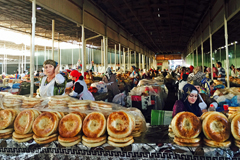JICA-RI Focus Vol. 43 - Interview with Research Fellow Eiji Yamada
2018.11.01
Spatial economics involves allocating various data geographically and adding specific perspectives, such as the perspective of environmental impact, to conduct analyses. Research Fellow Eiji Yamada has utilized his strengths in this area to be involved in a variety of projects, including the "Study on Remittances and Household Finances in the Philippines and Tajikistan" and "A Study on Urban Air Pollution Improvement in Asia." We asked him about the significance of utilizing those methods.

■ Profile
Master of Economics, Graduate School of Economics, the University of Tokyo; PhD Candidate, Department of Economics, Paris Institute of Political Studies. Joined the Japan Bank for International Cooperation (JBIC; merged with JICA in October 2008) in April 2008; served in South Asia Division 5, South Asia Department(assigned to Bangladesh) and the Financial Risk Management Division of the General Affairs Department; in his current post since August 2014.
- What led up to your decision to use spatial economics to analyze developing countries?
In elementary school, I memorized everything in an almanac of information about countries around the world in preparation for a quiz competition. That is what first got me interested in developing countries. Why are there countries throughout the world with high levels of income and those with low levels of income? Why does the gap increase? When I was in high school, I became interested in working for the United Nations in the future. I looked into it and found that economics was always included as one of the specialties on the recruitment examinations, so I thought it would help. That is what motivated my decision to study economics.
I first became aware of spatial economics in my fourth year in college when I happened to read "The Spatial Economy: Cities, Regions, and International Trade" (Toyo Keizai Inc., 2000) by economist Masahisa Fujita, et al. The book is a collection of theoretical findings up to that point in time. It addressed the issue of why there were some places in the world at which the economy grew, income was high, and industry, people, and money were concentrated, and some places where that did not happen. It discusses this from a spatial and geographical perspective. I felt it skillfully reflected on the real world, and it intrigued me deeply. It was also interesting that mathematical models were often complex, and it was frequently impossible to obtain solutions without computerized calculation. I have been interested in spatial economics ever since.
Spatial economics provides a framework for analysis that includes such matters as space, distance, and the cost of transportation linking two locations. It makes it possible to think about the meaning of "space." Most research in spatial economics was theoretical at the time Fujita's book was published, but recently, analysis of various development policies has utilized actual data from developing countries, to study the returns from road and railroad infrastructure, special economic zones, and the impact of such measures. I believe that it is effective to utilize spatial economics methodology to analyze development in developing countries. The reason is that thinking without ignoring the connections that always exist between individuals and regions makes it possible to accurately grasp the impact, benefits, and disadvantages of policies, and facilitates a greater long-term perspective on those aspects.

Eiji Yamada (third from right) presented the research result about Delhi Metro at the ieConnect for Impact Workshop in July, 2017
In addition, a variety of positional information is more easily obtained, even for developing countries, and software for processing that data has been advancing. This information includes road network infrastructure, the status of land use, the status of environmental pollution and nighttime city lights data, which is an indicator of economic activity. The methodology of spatial economics makes it possible to conduct exhaustive analyses of developing countries as well. I have also used geographical information system (GIS) software in research on air pollution in China, and in research on the impact of the Delhi Metro on women's labor opportunities I am conducting with JICA Research Institute Research Fellow Mai Seki and others, and am using this kind of data.
- Please tell us about your current project, "Study on Remittances and Household Finances in the Philippines and Tajikistan."
This research involves a multifaceted analysis of the impact of remittances from migrant workers on the Philippines and Tajikistan. It is intended to be used in formulation of policy proposals in developing countries that are dependent on overseas remittance. I am working with JICA-RI Research Fellow Enerelt Murakami and Visiting Scholar Akira Murata, local researchers in the Philippines and Tajikistan and researchers from the World Bank and the Asian Development Bank to collect data, and we are collaborating while at the same time exploring our own fields of interest.
The Philippines has a history of sending out migrants. We selected two regions that are highly dependent on migrant workers, and conducted an interview survey of households that receive remittances and those that do not. In Tajikistan, dependence on migrant work, particularly in Russia, has grown since the fall of the Soviet Union and subsequent civil war. In some years, remittances from migrant workers have constituted about half of the country's GDP. A monthly telephone survey of 800 households in Tajikistan being conducted jointly with the World Bank and utilization of a panel for a nationwide investigation of households conducted by the World Bank in 2013, etc., have been used to compare consumption and investment patterns, the flow of money after remittances have been received, and the impact on the motivation to work of family members remaining in the country. The research aims to clearly identify the differences.
Currently, I am particularly interested in the spatial-economic cost of dependence on migrant workers. In the case of Tajikistan, it appears that sending workers overseas actually leads to a shrinkage in domestic markets. While it is possible that remittances increase household income, the demand created by the migrant workers themselves goes with them to the locations where they work. Considering the loss of this "home-country market impact," it is possible that migration has currently exceeded the socially optimum scale, so I would like to verify that. In addition, we are comparing the differences in the means of transportation people use on a daily basis between households receiving remittances and those not receiving them. We believe that we can conduct comparisons of whether households receiving greater remittances and having higher budgets for transportation costs travel more, or whether they travel less because household work has increased due to the decreased number of family members who perform household chores.
- What are your findings at the current stage of your research?
We are currently still at the data collection stage, but the results of the telephone survey in Tajikistan suggest that receiving remittances leads to a decrease in provision of labor by the household. In other words, the family members remaining in the home country lose motivation to work and stop working. It seems like an obvious result, but from a labor economics perspective, some theories say that it is easier for households receiving remittances to start their own businesses and look for employment, and therefore work more. In Tajikistan's case, because the hourly wage for working in Russia is higher, it is also possible that the reservation wage--the wage below which people will not work--has also increased. When I visited the Ministry of Labor, Migration and Employment in Tajikistan previously, I was told that few people apply even when the government tries to recruit workers through public works projects designed to create employment domestically. That episode is consistent with our findings at this stage.

Yamada visited Tajikistan for a field research to get new information on people's lives
We are gathering a variety of data, such as details regarding the skills of migrant workers, the financial costs of migration and the status of financial inclusion of migrants and households, so I hope to be able to gain a multifaceted understanding of circumstances in the two countries through this research.
- Please tell us about "A Study on Urban Air Pollution Improvement in Asia."
The aim of this research is to analyze the circumstances and factors involved in emissions in Asian countries in relation to PM 2.5, which has an increasing level of emissions, and other contaminants, in conjunction with rapid economic growth and urbanization, and to consider policy to improve the air environment. I am analyzing air pollution in China using the framework of spatial economics.
Why is air pollution so bad in China? Lax regulations are given as a reason, but China is very large and there are significant differences between cities in the levels of regulation. Both the central government and regional governments fear decreased economic competitiveness and a loss of employment, and are therefore unable to take that step into strengthening regulations. So, is it really impossible to achieve both economic development and environmental improvement? Although the cost of environmental protection may delay economic development, it is also possible that strengthening regulations would lead to the growth of industries related to protecting the environment, or that the improved health of workers would lead to an increase in productivity. The spatial-economic forecast is that it is possible that overall performance will not weaken even if restrictions are tightened in a certain location.
Accordingly, we are utilizing data on approximately 300 cities throughout China (environmental protection/regulation budgets, status of contaminant emissions, economic statistics) and road network information, etc., to create a model of China's overall economy, and conduct hypothetical simulations of how much contaminant emissions and economic output would change if the level of regulation was changed in each city. We believe that determining which regions require more focused regulation will lead to policy recommendations aimed at achieving both environmental improvement and economic growth. Further, we would like to include changes in barriers to domestic migration in China, changes in people's awareness of environmental pollution, and other related matters in our analysis, and gain the ability to make realistic, timely recommendations.
- In light of your research up to this point, what are your discoveries, and what is the future outlook?
I think each of the projects is leading to elucidation of difficult-to-see costs and benefits. For example, in our research in Tajikistan, this would be the loss of home-country market impact or the loss of domestic employment opportunities, which might be overlooked by households, workers themselves, or the government. Further, NGO staff members who provide support to migrant workers have told me that many migrant workers damage their health in poor working environments then return to their home country. This might also be a cost of migration overlooked by many migrants.
Moreover, I think we will probably find that stricter regulation of air pollution in China will have little impact on the overall economy. Thinking back, insufficient regulation up to this point has been extremely costly. Air pollution has been pointed out as having an adverse effect on children, the elderly and people with respiratory disorders, but recent international case studies have also shown that exposure to pollution actually significantly reduces the labor productivity of healthy people as well. This increases the urgency of the situation all the more. When we consider the cost of the environmental burden including those factors, we can see that past environmental measures have been weak.
Considering the research up to this point, I have a renewed sense of the difficulty of the roles of the government and the public sector. There are sure to be costs and lost benefits if the government does not take appropriate action, but we do not know all of them. Circumstances vary by country and region. What should governments and governmental agencies do? By steadily accumulating research and a variety of case studies, I believe that humankind can gradually become wiser, thereby improving the situation, and that JICA should also contribute through international cooperation. Regardless of what work I am involved with in the future, I hope always to keep in mind the use of spatial economics and my experiences with data collection at JICA-RI as a foundation for identifying problems, gathering data, and generating output as I work.

事業事前評価表(地球規模課題対応国際科学技術協力(SATREPS)).国際協力機構 地球環境部 . 防災第一チーム. 1.案件名.国 名: フィリピン共和国.

事業事前評価表(地球規模課題対応国際科学技術協力(SATREPS)).国際協力機構 地球環境部 . 防災第一チーム. 1.案件名.国 名: フィリピン共和国.

事業事前評価表(地球規模課題対応国際科学技術協力(SATREPS)).国際協力機構 地球環境部 . 防災第一チーム. 1.案件名.国 名: フィリピン共和国.

事業事前評価表(地球規模課題対応国際科学技術協力(SATREPS)).国際協力機構 地球環境部 . 防災第一チーム. 1.案件名.国 名: フィリピン共和国.

事業事前評価表(地球規模課題対応国際科学技術協力(SATREPS)).国際協力機構 地球環境部 . 防災第一チーム. 1.案件名.国 名: フィリピン共和国.
scroll